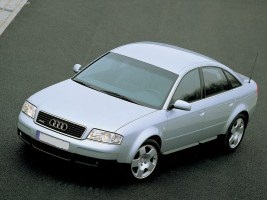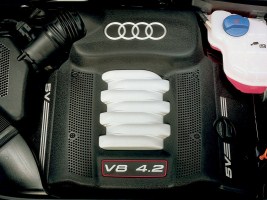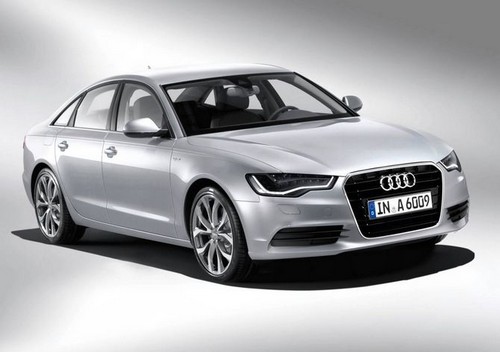Audi A6 1997 – 2004 - polovnjak, experiences, failures

Audi A6
Samo tri godine nakon zamene dugogodišnje serije 100 sa elegantnim Audi A6, Audi je ponovo podigao konkurenciju sa izuzetno inovativnim i upadljivim stilom nove generacije Audi A6. Audi A6 novi smeo izgled će bez sumnje biti ono što privlači pažnju većine ljudi kod automobila.
Odlična kabina, miran rad motora, a buka svedena na minimum – pravi automobil za duža putovanja. Ne baš sportska vožnja, ali Audi A6 tome nije ni namenjen. Preporučuje se model posle restajlinga, kada je porađeno na vešanju, a obavezno proveriti elektroniku, posebno podizače prozora i svetla.
Karijera Audi A6 modela se poklopila sa najmračnijim godinama brenda u pogledu pouzdanosti, posebno od 1998. do 2003. Ukupan kvalitet izgradnje nikada nije bio aljkav, neki elementi koji su montirani pokazivali su slabosti, poboljšanja su ponekad sporo dolazila. So, budite oprezni pre kupovine: čak i ako je automobil izuzetno dobro – što je obično slučaj, jer završna obrada tela i unutrašnjosti je izuzetna – kupovina može biti zamka, sa zastrašujuće velikim troškovima zamene ovog ili onog neispravnog elementa. U lavirintu broja verzije i velikog broja potencijalno kvarljivih stvari, nije lako odabrati koji modela da se izbegne. Neke verzije Audi A6 su uvek za izbegavanje, zbog loše pouzdanosti, kao i svi modeli sa automatskim menjačem kontinuirano promenljivim “Multitronic” svakako veoma prijatan na papiru, ali to nikada nije bila prednost ovog modela.
Dobro izgleda, vrlo dobro građen, prostran, komforan i prefinjen. Suptilno je jedini način da se opiše Audi A6, i za mnoge kupce može da bude pozitivan. Izbor Audi A6 znači da ste odlučili da se ne pridružite BMW / Mercedes publici.
Audi A6 je stekao dobru reputaciju čvrstog vozila sa poslovnim stilom. Još bolje za Audi A6 je što nije tako skup kao rivali BMW serije 5 i Mercedes E klase.
Audi A6 koji je bio prvi model koji koristi “A” u njegovo ime, pokrenut je u junu 1994. Ponuđeni kao limuzina i karavan obliku, on je imao veliku reviziju u 1997. i ostaje izuzetno važan model u ponudi Audija. Audi 100 je osvežen i pretvoren u Audi A6. Eksterijer je uglavnom ostalo nepromenjeno kao i motori, do 1997. Audi A6 došao sa nekoliko različitih motora dva dizela i mnogi od njih dostupni sa pogonom na četiri točka, Audijev quattro pogon. Spada u gornju klasu limuzina i karavan, ona se direktno takmiči sa modelima kao što su Mercedes – Benz E-Class, BMW 5 -Series, Jaguar S-Tipe, Leksus GS i Volvo S80.
Iako nije toliko rasprostranjena kao Audi A4 u smislu prodaje, 1998. Audi A6 pruža odličnu luksuzno vozilo sa odličnim spiskom standardne opreme koja se može dodatno poboljšana sa opcijama. Audi A6 se takmiči sa BMW i Mercedes – Benz kolegama. generally, Audi A6 pokazuje unapređen u odnosu na Audi A4. Oba vozila dele sličan stil i veliki izbor motora i tela. Audi A6, however, dodaje više standardnih funkcija, veći niz opcionih karakteristika i veću prostraniju kabinu. Audi A6 čini dobar luksuzno vozilo. Ona takođe služi kao najlogičniju nadogradnju za Audi A4 u floti.
DIZAJN I UNUTRAŠNJOST – Audi A6

Audi A6
Audi A6 predstavlja eleganciju, pouzdanost, snagu, praktičnost i svestranost. Enterijer je dizajniran odlično, kvalitet materijala je na nemačkom nivou. Napred ima mesta na pretek, a pozadi bez problema mogu komotno da se smeste tri odrasle osobe. Vozač i suvozač sede na velikim sedištima i koji snažno pridržavaju telo. Ljudi koji se voze nazad dobro su zbrinuti , Audi nudi dovoljno prostora za noge i prostora za glavu ne manjka. Tri pojasa su standardna pozadi, kao i tri naslona za glavu podesiva po visini.
Ono što je loša strana Audi A6 je agilnost. U odnosu na BMW 5 je nekako lenj i dosadan. So, ako pored svega navedenog na početku tražite i sportske performanse i uživanje u vožnji, nemojte kupovati ovaj polovnjak. Da napomenemo i da je buka u kabini svedena na minimum kako po gradu, tako i na otvorenom putu. Nakon 2001. je urađen restajling kada je dosta porađeno na vešanju.
Iako Audi A6 nema preklapanje zadnjeg sedišta, prtljažnik je prostran, dug i širok, a pod je ravan.
MOTOR – Audi A6

Audi A6
Široka paleta motora Audi A6 počinje sa 1,8T četvoro cilindričnim benzincem. Pristojan izbor, isto kao i 2,0. However, uz Audi A6 idu najbolje V6 motori kojih ima sa 2,4, 2,7T, 2,8 i 3,0 litara radne zapremine. Prosečna potrošnja za V6 motore je prema fabrici oko 8 litara bezolovnog benzina, ali imajte na umu da ovo u gradu može drastično da se poveća. Najveći benzinac je V8 4,2L i on se ne preporučuje kako zbog jako visoke registracije tako i zbog potrošnje koja je ogromna.
Ako tražite umerenu varijantu, tu su i dizel agregati koji su se odlično pokazali. 1,9 je najmanji, a tu su i dva V6 2,5 TDI-a. Prosek potrošnje je oko 7 l, a ovi motori odlično vuku.
Energičan 1.8T je bolji izbor od 2.0 – litarskim benzinskim koji je malo slab i spor . Nećete biti razočarani od strane bilo kojeg drugog motora mada 2.7T sa 230 KS je posebno dobra jedinica i daje dobre rezultate, tu su i 2,4 – litarski, 2,8 – litarski i 3,0 – litarski motor. As for diesels 1.9 TDI je izbor za svakodnevne situacije, ali ako redovno vučete ili nosite teški teret onda 2.5 TDI (bilo je dostupan u 155 KS, 163 the KS 180 KS) je bolji izbor.
Prosečan Audi je ponuđen sa dva dizel motora u više verzija. Poznati 1.9 TDI motor, koji se pojavio u verzijama sa snagom od 110, 115 i 130 KS. Potrošnjom od 6 – 8 litara dizela na 100 km, jedini problemi može izazvati turbo punjača.
On the other side, tu je još moćniji motor 2.5 TDI sa 150 KS, 163 the KS 180 KS. Iako pruža zaista dobre rezultate (sprint od 0 do 100 km / h može da traje manje od 9 seconds, a za razliku od 1.9 TDI dostupan je sa quattro pogonom), ali nema tako dobre kritike. Potrošnja od 8 – 10 liters in 100 km je prihvatljiva, ali vozači se žale zbog neuspeha nekih komponenti, kratkog trajanja zupčastog kaiša i bregastog vratila. Mlađi primerci Audi A6 posle fesliftinga 2001., je očigledno manje sklon kvarovima.
Svi modeli, osim 2,0 benzinskim i 1,9 TDI su dostupni sa pogonom na četiri točka, Quattro pogonom.
Motori su dostupni u kombinaciji sa 6 ili 5 stepeni manuelnim menjačem ili dve automatska menjača. Kupci u ovoj oblasti imaju izbor šesto-stepenog Tiptronic-a i 6 stepeni CVT kontinuiranim varijabilnim prenosom koji se kod Audija zove Multitronic. Na početku proizvodnje je bio dostupan 4 – stepeni automatski menjač.
Osnovni motor za Audi A6 ( 2.0 , 2.6 , 2.8 , 3.0 , 4.2 V8 ) radi dobro sa sekvencijalnom instalacijom ubrizgavanja gasa.
ISTORIJA MODELA – Audi A6:
1997. : predstavljanje modela Audi A6 (limousine), novi asortiman motora: 1.8 20 V (150 KS), 2.4 V6 30 V (165 KS), 2.8 V6 30V (193 KS) i 1.9 TDI (110 KS);
1998. : Before ( caravan ), novi motori 1.8 20V (125 KS) i 2.5 TDI V6 24V (150 KS);
1999. : engines 2.7 V6 30V (230 KS) i 4.2 V8 40V (300 KS), 2.5 TDI V6 24V (180 KS), sportska verzija S6 4.2 40V motor V8 (340 KS);
2000. : 1.9 TDI (115 KS);
2001. : fejslifting, novi asortiman motora: 1.8 20V (150 KS), 2.0 20V (131 KS), 2.4 V6 30V (170 KS), 3.0 V6 30V (220 KS), 2.7 V6 30V (250 KS), 4.2 V8 40V (300 KS) i 1.9 TDI (130 KS), 2.5 TDI V6 24V (155 ili 180 KS);
2002. : sportska verzija RS6 V8 4.2 40V motorom (450 KS); 2004. : novi model Audija A6;
KVAROVI – Audi A6
Ukoliko je redovno održavan, ni jedan Audi A6 ne bi trebalo da vam zada mnogo muka. So, najbitnija stavka je servisna knjižica. U slučaju da redovni servisi nisu rađeni na vreme, rizikujete da kupite automobil koji će zahtevati dosta ulaganja, a u Audijevom slučaju to nije nimalo jeftino.
Problemi sa sa motorom. U slučaju popularnog TDI je tipično oštećenje protokomera, kvar pumpe visokog pritiska ( osetljivost na korišćenje kvalitetnog goriva ), zanemarivanje redovnog i skupog održavanja (zamena zupčastog kaiša) havariju motora, čije su posledice su veoma skupe za uklanjanje. Dizel motori TDI je atraktivan zbog niske potrošnje goriva.
Motori Audija A6 imaju problema sa curenjem rashladne tečnosti iz pumpe za vodu i probleme sa pumpom za ulje zbog turbo punjača, kao i manja kvarove senzora temperature (nije uključen ventilator) i blokiranjem termostata (pregrevanja). However, oni mogu dovesti do ozbiljnih posledica – pregorevanja dihtunga glave motora ili čak havarija motora. Problem sa EGR ventilom (zahtevaju redovno čišćenje). Test vožnja pri kupovini je stoga potrebna radi provere da li se motor gasi na praznom hodu i ne podiže temperaturu. Nakon vožnje je potrebno pogledati motor, jer curenja motornog ulja na A6 javljaju vrlo često.
Zupčast kaiš kod 1.8 20V potrebno je menjati pre 4 godine ili 60000 km ( šta pre nastupi) i remena u isto vreme. at 1.8 20V motora pucanje zupčastog kaiša na 70 000 – 80 000 km može izazivati veliku štetu.
Svi 1.8 20V turbo motori izrađeni od avgusta 2001. until October 2002. mogu da pati od otkaza ili više do četiri bobine, što je dovelo do spora između VAG i dobavljača.
V6 benzinski motori sa 12 valve. Imaju tendenciju da troše mnogo ulja u početku eksploatacije. Bez ikakvih ozbiljnih posledica.
2.8 V6 sa 12 valve. Neki slučajevi curenja rashladne tečnosti preko račve u obliku V, pod usisnom granom.
U slučaju šestocilindričnog V6 benzinskog motora potrebno je obratiti pažnju na nivo ulja, troše ulje. U drugim verzijama benzinaca često curenje ulja iz motora i menjača.
Potapajuća pumpa u rezervoaru kod benzinaca, zna da otkaže, posebno zimi, zbog vode u gorivu.
TDI motor. Na dizelima do proleća 2003., postepeni pad snage od 6 000 km. Na kraju može da dovesti do potpunog odsustva ubrzanja iznad 120 km / h. Uzrokovana zaprljanošću merača protoka vazduha. Ne čistiti ga, zameniti ga.
Motor 1.9 TDI. Imaju tendenciju da troše mnogo ulja u početku eksplatacije. Bez ikakvih ozbiljnih posledica.
Motor 1.9 TDI. Na modelima proizvedenim do juna 1998. curenje ulja na zaptivnom prstenu radilice.
Motor 1.9 TDI 110. Na 1.9 TDI 110 je do jula 1998. usled zaprljanosti rizik loma krilaca turbine sa varijabilnom geometrijom. Uglavnom kod automobile voženih po gradu.
1.9 TDI motor 110. Na modelima proizvedenim do juna 1999., usporava anarhični prilikom povratka u prazan hod. Uzrokovana problemom u ECU motora.
Katalizator. Na TDI 110 proizvedenim do maja 1998. vrlo rano uništenje katalizatora (interna keramika), ponekad sa 25 000 km. Zamenjeno na većini automobila.
Gubitak snage na TDI 90 KS – 110 KS preko 3 000 obrtaja može da se reši zamenom tankog creva koje ide od turbine do ECU.
2.5 TDI motor, failures pumpa za gorivo i bregaste osovine.
V6 TDI 150 KS. Na modelima proizvedenim do jula 1999., moguć kvar pumpe za ubrizgavanje na 120000 km. U ovom slučaju, potrebna zamena.
V6 TDI 180 KS. Rizik od loma krilaca turbo punjača promenljive geometrije.
Pumpa za vodu . Na V 6 TDI je do juna 1999., često curi pumpa za vodu.
Turbo punjač ume da strada kod modela sa 2.5 V6 dizel motorom, a zabeleženi su i kvarovi na meraču protoka vazduha.
Automatski Multitronic. Hronične brige. Mnogi kvarovi automatskog kontinuirano varijabilnog prenosa, ponekad teški i zahtevaju potpunu zamenu, ponekad već od 60000 km.
Optički farovi. Posebno na modele proizvedene do maja 2001., vibracije farova. Fenomen izražen i kod modela sa optičkim ksenonskim.
Podizači prozora. Na svim modelima, naročito onim koje su proizvedeni do 2001., ponavljaju se problem sa podizačima prozora.
Kada je reč o neuspesima električnih sistema i sistema osvetljenja, mnogi korisnici žale na potrebu za čestim zamenu sijalica.
Ponekad ne funkcionišu pokazivač nivoa goriva i temperature motora, serviseri ovo povezuju sa vraćanjem kilometraže.
Potrebna redovna provera ventilacione komore, ie. odvoda za vodu. Ako se odvod blokira lišćem, voda neće imati gde da odu osim u auto, što može da izazove električne i elektronske probleme. Benzinski motori mogu imati dodatne problem, voda blokirana u ventilacionoj komori, ie. odvodu za vodu, voda može ući u kočioni servo, izazove rđaju iznutra i koči teško automobil . Ta voda može biti usisana u motor, ako servo membrana popusti.
Prilično čudna pojava C5 je prikupljanje vode u posudi za baterije.
Osnovni i najčešći problemi kod Audija A6 je prednjeg trapa. Kompleksni trap šestice može da bude problematičan, posebno gornja oscilujuća ramena (po 4 na svakoj strani) i stabilizujuća ramena.
Nije neobično da oznake na displeju bord kompjuteru nestanu.
Na samom početku bilo je nedostataka kod kontrolne jedinice ABS-a.
Polovnjak Audi A6 cene – pregled

Hi there, I am Mladen and I am an auto enthusiast. I started this blog years ago to help like minded people share information about latest cars, car servicing ideas, used car info, exotic cars, and auto technology. You will find helpful articles and videos on a wide variety of cars – Audi, Mercedes, Toyota, Porsche, Volvo, BMW and much more. Ping us if you have anything cool to share on latest cars or on how to make older cars more efficient, or just want to say hi!



Postovani, imam audi a6 2.5 tdi 114kw 155ks 2002 godiste. na autu je crkla bosch pumpa,tj elektronika na pumpi, majstor je morao da razupci motor kako bi skinuo kompletnu pumpu, onda je sve to odradjeno i vraceno na svoje mesto, kad sam preuzeo auto na autu se cuje bregasta da zvekece a nije se cula nikada pa me zanima u cemu je problem ako neko zna zahvalan unapred.
Imam audija a6 c5 1,9 tdi 81kw 98god. Pukla mi je sajla od gasa i nigdje ne mkgu da nadjem drugu.Da li neko zn kolika je duzina te sajle posto mi majstor nije mogao naci tu sto je pukla